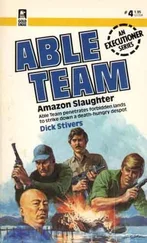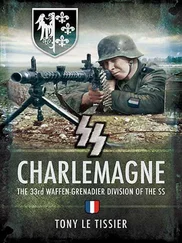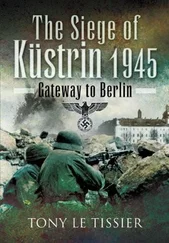Baruth, the nodal traffic point on the east–west flow of the Baruther Urstromtal (glacial valley) with its swamps and streams, was recognized as the critical exit point for a German break-out from the Spreewald. [1] GPW , p. 381; Koniev, Year of Victory , pp. 121–2.
Much as he would have liked to concentrate on Berlin, Koniev had other urgent responsibilities, as he described:
The difficulty of my position, as commander of the front, was that operations were developing simultaneously in several directions and each of these directions required attention and supervision. Fighting for Cottbus was still going on in the north, while in the centre, after the liquidation of the Spremberg area of resistance, our troops were confidently advancing towards Berlin and the Elbe. On our left flank, however, in the Dresden direction, we were still having a hard time of it, and this distracted me very much from our main attack.
Koniev was also responsible for 6th Army besieging Breslau well in his rear, but there he could urge restraint. He also sent his Chief of Staff, General Petrov, to deal with his problems on the southern flank. [2] Koniev, Year of Victory , p. 124.
By evening the leading elements of 3rd Guards Tank Army had come close to the outer sections of the Berlin Defence Area, and some of their scouts reached Königs Wusterhausen from the south, thereby effectively completing the encirclement of the German 9th Army. Although, as they were on the other side of the water complex from Colonel-General Chuikov’s 8th Guards Army, the troops of the two Soviet fronts remained unaware of their proximity to each other. [3] Ibid ., p. 122.
Meanwhile 4th Guards Tank Army’s 5th Guards Mechanized Corps continued to be heavily engaged in the Jüterbog area. The vanguard of 10th Guards Mechanized Brigade, having bypassed the town through the woods to the north during the night, reached the northern perimeter of the Altes Lager at daybreak and was met by fire from anti-tank guns, SPGs and Panzerfaust-armed infantry, which were shortly reinforced by the arrival of a troop of tanks coming from Treuenbrietzen. The brigade commander, Colonel V. N. Buslaiev, then sent off 51st Guards Tank Regiment to secure the right flank in the Niebel–Treuenbrietzen area, while the main body engaged the Altes Lager defences. These were overrun by the end of the morning with Soviet claims of four German tanks and two armoured personnel carriers (APCs) destroyed. Some large camps were then discovered nearby containing prisoners of war and forced labourers from Russia, Poland and France.
The local Volkssturm units, which had been deployed in defence of Treuenbrietzen the previous evening, disbanded themselves on the morning of 21 April, leaving the town’s anti-tank barriers open and unguarded. The first of 51st Guards Tank Regiment’s tanks arrived at 1700 hours and by 1900 hours twelve had passed through the town heading for Wittenberg with about a company of infantry on board. The inhabitants had expected American, not Russian troops, and some had already hung American flags from their windows, but these were soon replaced with white ones when the locals realized the identity of the intruders. Some elements of the Friedrich Ludwig Jahn Division, which were in the town, hastily withrew to the western outskirts after losing an SPG and then came under Soviet artillery and mortar fire. They then mounted a counterattack, but this was repulsed with the loss of two tanks.
While this was going on, another part of Lieutenant-Colonel E. I. Grebennikov’s 51st Guards Tank Regiment took Niebel without a fight that afternoon after having bypassed Treuenbreitzen well to the east. [4] Kreisleitung Jüterbog booklet, pp. 13–19.
On 3rd Guards Tank Army’s line of advance on 21 April 1945 we have this account from Willi Klär, from Kummersdorf Gut, where the German Army’s main artillery testing ranges were located. The complex included barracks, workshops, stores, a secret atomic and chemical warfare research laboratory complex, its own railway station and sidings, as well as some military and civilian accommodation. However, apart from the military families living on site, most of the civilians employed here lived in the main village, a new settlement resulting from the increased activity arising from Hitler’s military expansion and located a kilometre away to the north-east off the Sperenberg road. (This should not be confused with the main village of Kummersdorf, which lies immediately beyond Sperenberg several kilometres north of the military installation, although ‘Kummersdorf ’ to most German soldiers meant the ranges at Kummersdorf Gut.)
Our village was spared the bombing attacks on Berlin. Only once an aerial mine landed near the railway level crossing near Schönefeld village and some incendiaries landed between the water tower, market garden, barracks and our village, but did little damage. The aircraft came from the direction of Luckenwalde, where they had dropped some bombs. A house and seven barns were set on fire in the nearby village of Horstwalde by incendiaries dropped by the same aircraft.
There were no proper air raid shelter facilities for those living in the village or near the ranges, only the cellars of their houses and some slit trenches covered with concrete slabs and sand. There was one in front of the old folks’ home. The constant air alerts were frightful and made the people exhausted, putting their nerves on edge.
On 20 April 1945 all the men and youths still remaining in the village were rounded up to stop the advance of the Red Army, which had already reached Baruth. During the night of 20/21 April the Volkssturm had to dig foxholes in the cleared ground beyond Lindestrasse, Birkenallee and Am Ring. They were supposed to stop the tanks with their rifles.
Soldiers were deployed on the ranges from the forest warden’s lodge, where the command post was located, along the main road to Schönefeld. The first enemy tanks approached the Königsgraben on the Horstwalde road early on the morning of 21 April.
An engine-less Tiger tank and a 75-mm anti-tank gun had been deployed in defence of the bridge over the Königsgraben but, after a brief exchange of fire, the crews abandoned them in face of the overwhelming numbers of the enemy.
None of the modern weapons being tested on the ranges were brought into use on 21 April, or our losses would have been even greater.
The soldiers deployed on the ranges also abandoned their positions after a short exchange of fire. Most of the local inhabitants who had been deployed in the defence outside the village were captured. Some died a hero’s death and a few were able to escape, withdrawing to the Elbe, only to return home a few weeks later exhausted and half-starved.
Some of the ammunition stores were blown up as the Red Army approached on 21 April, as were the two industrial railway bridges over the main line to Sperenberg, and the industrial railway bridge over the main road to Sperenberg, in order to check the advance.
Three teenage youths, a young woman and four men over normal military age were killed during the fighting on 21 April. Most of the women and children had already fled on the evening of 20 April, or in the early hours of 21 April, to the observation bunker on the east range and remained there for a few days, returning to their homes once things had quietened down. [5] Ortschronik von Kummersdorf Gut , a handwritten document supplied by Rolf Kaim to the author.
Orders from Hitler for 9th Army, which were received by Heinrici at 1720 hours, were to hold on to the existing defensive line from Cottbus to Fürstenberg, and from there to curve it back via Müllrose to Fürstenwalde. At the same time a strong front was to be established between Königs Wusterhausen and Cottbus, from which repeated, vigorous and coordinated attacks were to be made, in cooperation with 12th Army, on the deep flank of the Soviet forces attacking Berlin from the south. [6] Lakowski/Stich, Der Kessel von Halbe 1945 , p. 42 [citing Federal Military Archives 19 XV/10, Sheet 60].
Читать дальше












